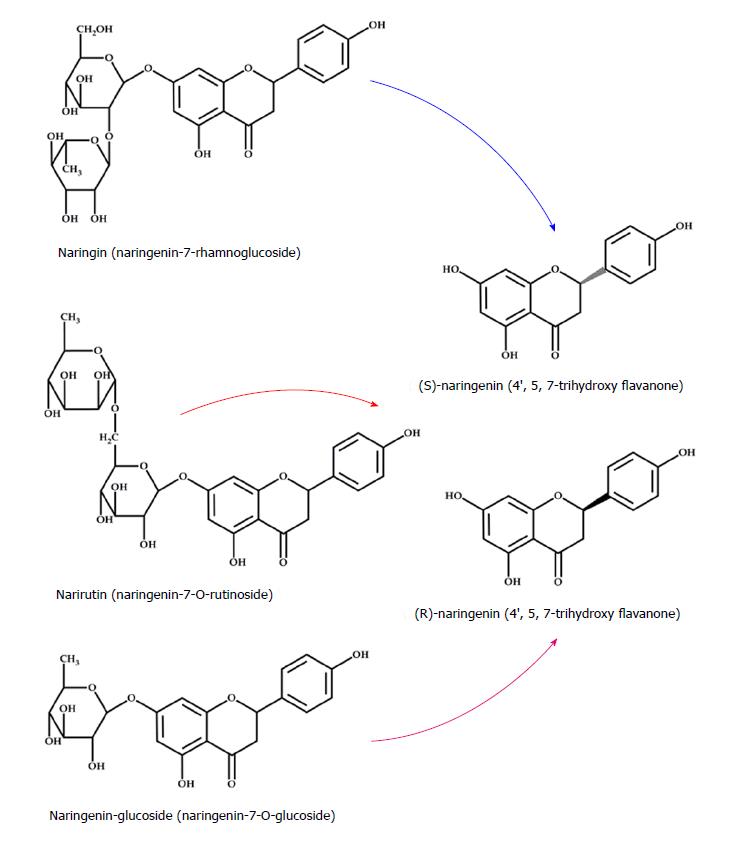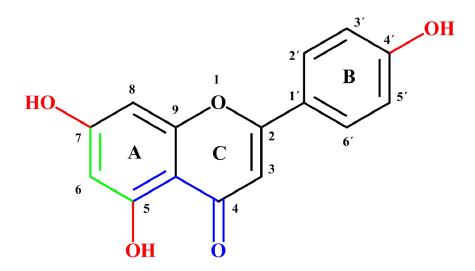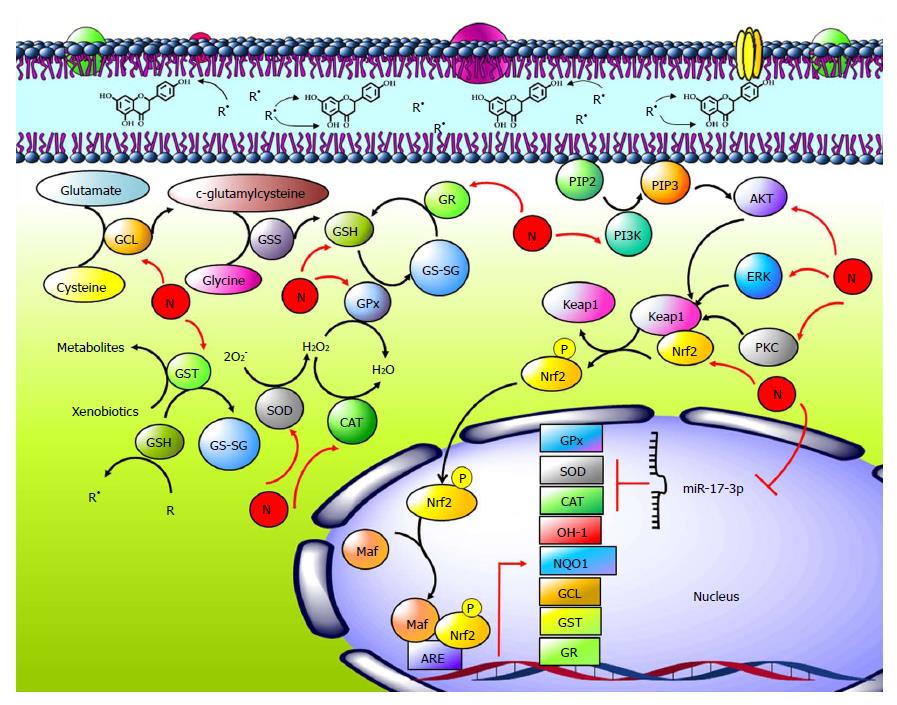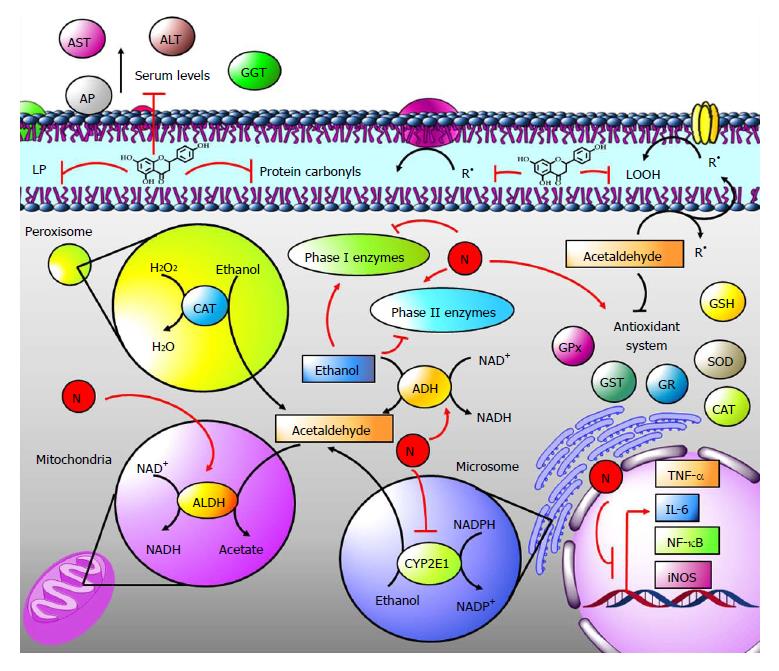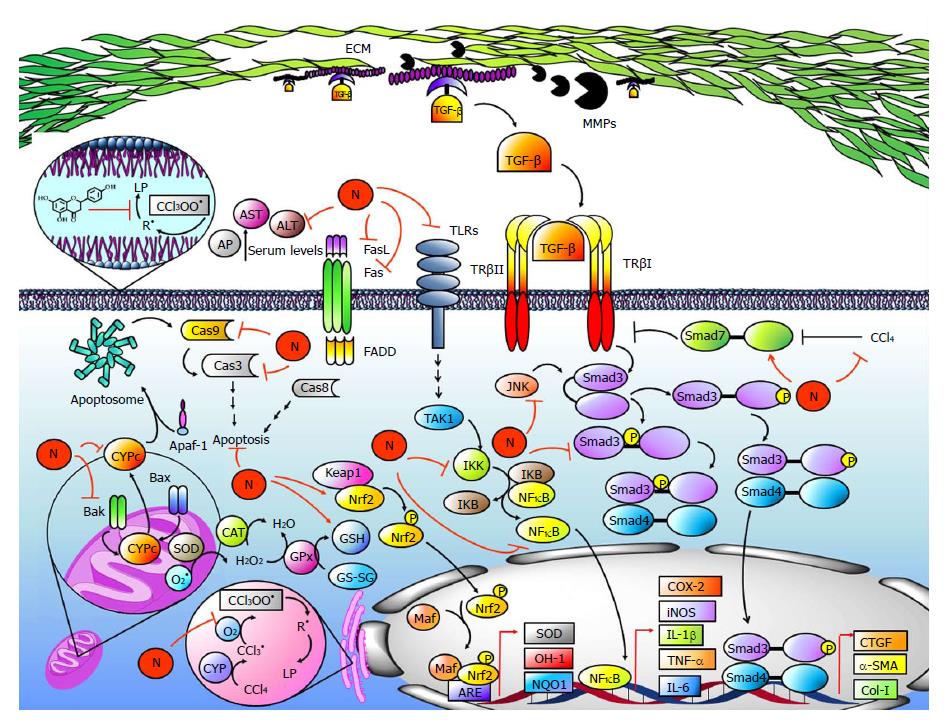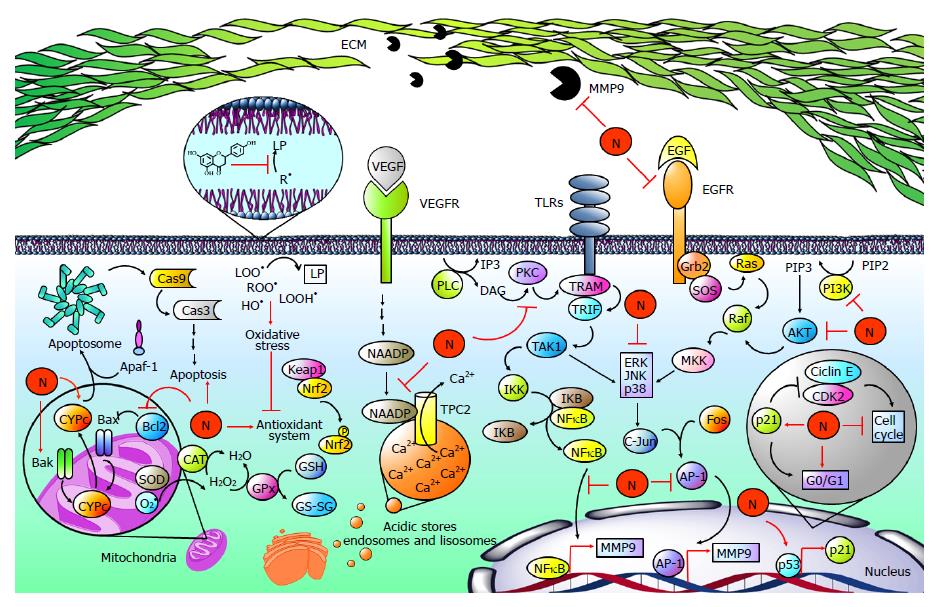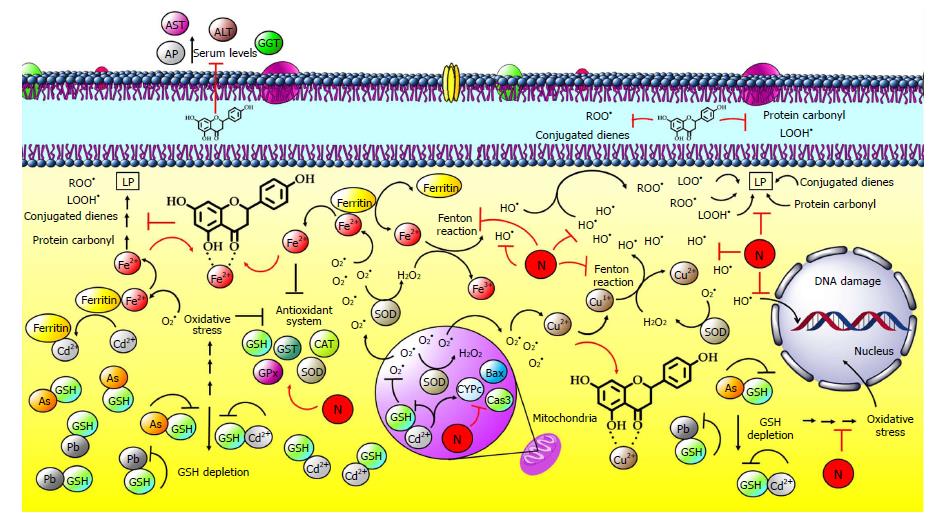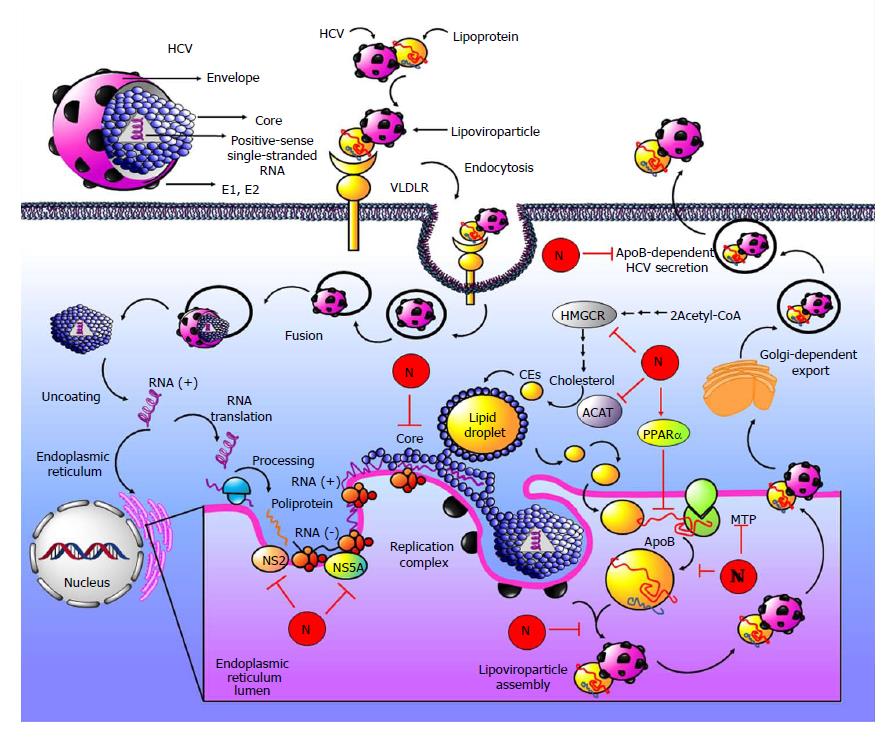Copyright
©The Author(s) 2018.
World J Gastroenterol. Apr 28, 2018; 24(16): 1679-1707
Published online Apr 28, 2018. doi: 10.3748/wjg.v24.i16.1679
Published online Apr 28, 2018. doi: 10.3748/wjg.v24.i16.1679
Figure 1 Chemical structure of naringenin, naringin, narirutin, and naringenin-glucoside.
The flavonoid naringenin exists in two forms: Glycosylated (naringin, narirutin and naringenin-glucoside) and aglycone (naringenina). There are three types of naringenin glycosides depending of sugar moiety bound to the flavonoid: Naringin (rhamnose), narirutin (rutinose) and naringenin-glucoside (glucose); when the sugar moiety is cleaved by specific enzymes, the aglycone (naringenin) is released.
Figure 2 Absorption and metabolism of naringenin.
Small intestine: Naringenin (N, orange arrows) is absorbed through the intestinal epithelium by passive diffusion into enterocytes; then, it can pass to general circulation by multidrug resistance associated proteins (Mrp1) or transported by active efflux protein carriers P-glycoprotein (P-gp) and Mrp2, back to the intestinal lumen, out of the enterocytes. Inside the enterocyte, naringenin is glucuronized by UDP-glucuronosyl transferase (UGT), and after that, naringenin-glucuronides (red arrows) leave cells by Mrp2 protein or pass into blood via breast cancer-resistant protein (Bcrp1). Moreover, naringenin-glucuronides can be cleaved by β-glucuronidases (GUSB), resulting in release of the aglycone. Large intestine: Naringenin undergoes same processes as in small intestine but also is highly metabolized by Streptococcus S-2, Lactobacillus L-2, and Bacteroides JY-6 to generate a series of low molecular weight aromatic acids. Liver: Naringenin is highly conjugated to form naringenin-glucuronides, which allows it to pass into circulation. On the other hand, naringenin-glucuronides reach the liver from intestine and enter into hepatocytes via organic anion transporting protein-B (OATP), and then, they are transported by Mrp3 into the circulation.
Figure 3 Naringenin antioxidant activity-structure relationship.
In red: Hydroxyl substituents (OH) that have high reactivity against reactive oxygen species and reactive nitrogen species. In green: 5,7-m-dihydroxy arrangement in the A-ring serves to stabilize the structure after donating electrons to free radicals. In blue: The association between 5-OH and 4-oxo substituents contributes to the chelation of compounds such as heavy metals.
Figure 4 Antioxidant effects of naringenin.
Naringenin (N) accumulates in cell membranes, where it provides rigidity to the lipid bilayer; naringenin can reduce the interaction between free radicals (R•) and the cell membrane, as well as reduce membrane phospholipid attack and prevent lipid peroxidation (LP). Glutathione (GSH) is formed when cysteine and glutamate form c-glutamyl cysteine by the enzyme glutamyl cysteinyl ligase (GCL); then, glycine and c-glutamyl cysteine form GSH by GSH synthetase (GSS). Naringenin increases GCLC protein and mRNA levels as well as GSH levels. Naringenin increases activity and protein and mRNA of superoxide dismutase (SOD), catalase (CAT), glutathione peroxidase (GPx), glutathione transferase (GST) and glutathione reductase (GR), enzymes that are part of the endogenous antioxidant system. Naringenin decreases the expression level of miR-17-3p; its targets genes are SOD and GPx. The nuclear factor-erythroid 2-related factor 2 (Nrf2) is an oxidative stress regulator; it stimulates antioxidant enzyme expression as well as heme oxygenase (OH-1) and NADPH quinone oxidoreductase (NQO1). Naringenin upregulates the Nrf2 pathway by increasing its activation, nucleus translocation, and protein and mRNA levels through PI3K/AKT, ERK and PKC.
Figure 5 The role of naringenin in alcohol-induced liver damage.
Alcohol metabolism: In the cytosol, alcohol is converted into acetaldehyde by alcohol dehydrogenase (ADH); it is also formed in microsomes by CYP2E1 and in peroxisomes by catalase (CAT). In mitochondria, acetaldehyde dehydrogenase (ALDH) transforms acetaldehyde to acetate. Ethanol elevates ADH and CYP2E1 activities but decreases ALDH activity, resulting in toxic acetaldehyde accumulation, free radical (R•) formation in the form of lipid hydroperoxides (LOOH) or protein carbonyls and resulting in the elevation of lipid peroxidation (LP). Naringenin (N) increases the activities of all those enzymes, which results in alcohol efficient elimination leading to endogenous antioxidant system restoration, oxidative stress prevention and balance of phase I and phase II xenobiotic metabolism enzymes. Naringenin also prevents increased levels of alkaline phosphatase (AP), aspartate aminotransferase (AST), alanine aminotransaminase (ALT), and γ-glutamyl transferase (GGT) as well as inflammation during alcohol-mediated liver damage.
Figure 6 Naringenin prevents acute and chronic CCl4-induced liver damage.
Carbon tetrachloride (CCl4) is activated by CYP2E1, CYP2B1, CYP2B2, and CYP3A (CYP) to form the trichloromethyl radical (CCl3•); then, it reacts with the oxygen-forming trichloromethylperoxy radical (CCl3OO•). The CCl3OO• initiates lipid peroxidation (LP), free radical (R•) generation, and imbalance of the endogenous antioxidant system formed by superoxide dismutase (SOD), catalase (CAT), glutathione peroxidase (GPx), glutathione (GSH), heme oxygenase (OH-1), NADPH quinone oxidoreductase (NQO1) and nuclear factor-erythroid 2 related factor 2 (Nrf2). Naringenin prevents CCl4 metabolism, LP and imbalance of the antioxidant system. Naringenin also prevents increased levels of alkaline phosphatase (AP), aspartate aminotransferase (AST), alanine aminotransaminase (ALT), and γ-glutamyl transferase (GGT). On the other hand, CCl4 increases intrinsic and extrinsic apoptosis pathways in hepatocytes; however, naringenin prevents CYPc release, as well as BCL2-associated X protein (Bax), BCL2-antagonist/killer 1 (Bak), Caspase 3 (Cas3) and Caspase 9 (Cas9) elevation, a protein related with the intrinsic pathway. For the extrinsic apoptosis pathway, naringenin prevents Fas and Fas ligand (FasL) increases produced by CCl4 administration. During CCl4-induced fibrosis, there is a proinflammatory environment generated by Kupffer cells and HSCs. The NF-κB pathway starts when TLRs are activated; then, intermediates are activated leading to inhibitor κB (IKB) phosphorylation by IκB kinase (IKK) and NF-κB release. NF-κB regulates inflammatory protein expression, including tumor necrosis factor-alpha (TNF-α), interleukin-6 (IL-6), cyclooxygenase-2 (COX-2), interleukin-1 (IL-1) and inducible nitric oxide synthase (iNOS), while naringenin maintains normal levels of these proteins during CCl4-induced liver damage. Transforming growth factor-β (TGF-β) activates receptor-activated Smad3 (Smad3), leading to transcriptional induction of α-smooth muscle actin (α-SMA), connective tissue growth factor (CTGF), and collagen-1 (Col-1). Moreover, Smad3 is also activated by JNK via linker domain phosphorylation. Naringenin prevents Smad3 activation and α-SMA, CTGF, and Col-1 elevation because it inhibits TGF-β elevation and JNK activation. Metalloproteases (MMPs) cleave extra cellular matrix (ECM) proteins, favoring TGF-β release as well as HSC migration to other sites, increasing fibrosis development; naringenin prevents MMPs elevation. On the other hand, CCl4 decreases Smad7 protein levels; this protein inhibits the TGF-β signaling pathway by TGF-β receptor I (TβRI) ubiquitination, but nevertheless, naringenin maintains normal levels of Smad7 during CCl4 treatment.
Figure 7 Naringenin in cancer development.
Hepatocellular carcinoma is strongly associated with elevated levels of free radicals such as lipid hydroperoxides (LOOH•), peroxyl radicals (ROO•), and hydroxyl radicals (OH•), leading to the development of lipid peroxidation (LP), oxidative stress and finally to an imbalance of the endogenous antioxidant system. Naringenin (N) inhibits oxidative stress by its intrinsic antioxidant properties and by improving the endogenous antioxidant system. Notably, oxidative stress has been linked to the hepatocarcinogenic process because it is implicated in the activation of mitogen activated protein kinases (MAPKs), nuclear factor-kappa B (NF-κB), or phosphatidylinositol-3-kinase (PI3K/AKT) pathways, increasing the production and activity of metalloprotease 9 (MMP9), which is involved in migration and invasion processes. When toll-like receptors (TLRs) are activated, TRAMP is recruited to activate TRIF; in turn, it promotes transforming growth factor beta-activated kinase 1 (TAK1) activation, which phosphorylates IκB kinase (IKK). Then, IKK promotes NF-κB release via inhibitor κB (IKB) phosphorylation. On the other hand, phospholipase C (PLC) catalyzes phospholipid hydrolysis, generating inositol triphosphate (IP3) and diacylglycerol (DAG); the latter is an activator of protein kinase C (PKC), which can induce the NF-κB pathway in a TRAMP-dependent manner. Then, NF-κB induces the expression of MMP9. Epidermal growth factor (EGF) is highly involved in carcinogenic pathways; it binds to epidermal growth factor receptor (EGFR) promoting Grb2, SOS, Ras, Raf and mitogen-activated protein kinase kinase (MKK) activation, which participates in extracellular signal-regulated protein kinase (ERK), c-Jun N-terminal kinase (JNK) and p38 (MAPK) phosphorylation and activation. Then, MAPKs promote activator protein 1 (AP-1) activation by c-Jun and Fos dimerization. After that, AP-1 induces the expression of MMP9. Alternatively, MAPKs are activated via PI3K/AKT. PI3K produces phosphatidylinositol (3, 4, 5)-trisphosphate (PIP3) from phosphatidylinositol 4,5-bisphosphate (PIP2); PIP3 activates AKT, which promotes MAPK activation in a Ras-dependent pathway. It has been reported that naringenin inhibits MM9 expression and secretion through diminution of p38, JNK, ERK, IKB, and PI3K/AKT phosphorylation as well as NF-κB and AP-1-DNA binding. In addition, naringenin inhibits PKC cytoplasm-to-membrane translocation. Notably, naringenin induces p53 accumulation, leading to p21 expression. Then, p21 inhibits cyclin E/cyclin-dependent kinase 2 (CDK2) complex, which participates in proliferation. p53 accumulation results in naringenin-induced G0/G1 phase arrests. An important mechanism for the elimination of cancer cells is apoptosis. Naringenin induces apoptosis by increased cytochrome c (CYPc) release, as well as BCL2-associated X protein (Bax), BCL2-antagonist/killer 1 (Bak) and Caspase 3 (Cas3) elevation. Additionally, naringenin inhibited B-cell CLL/lymphoma 2 (Bcl-2) an antiapoptotic protein. Two-pore channels (TPCs) are members of the voltage-gated ion channel superfamily localized in acidic calcium (Ca2+) stores and have been implicated in angiogenic processes. Vascular endothelial growth factor (VEGF) and its receptor vascular endothelial growth factor receptor (VEGFR) promotes TPC activation via nicotinic acid adenine dinucleotide phosphate (NAADP); then, Ca2+ is transported to the cytoplasm through TPCs, activating angiogenic signals. Naringenin inhibits VEGF angiogenesis induction blocking NAADP activation and NAADP/TPC association.
Figure 8 Naringenin inhibits hepatic damage induced by heavy metals.
Heavy metals can be classified according to the mechanism of action in redox-active metals such as iron (Fe) and copper (Cu) or redox-inactive metals such as cadmium (Cd), arsenic (As) and lead (Pb). One of the main free radicals is superoxide radical (O2•); normally, it is produced by NADP oxidase, and then, it is neutralized by superoxide dismutase (SOD), generating hydrogen peroxide (H2O2). Intracellular Fe is releases from ferritin by O2•; next, free Fe reacts with H2O2 in the Fenton reaction, generating high amounts of hydroxyl radicals (OH•). After that, OH• attacks double bonds of DNA bases. In the case of lipids, free Fe produces lipid peroxidation (LP) through peroxyl radicals (ROO•), producing lipid hydroperoxides (LOOH•), conjugated dienes and protein carbonyl. Regarding Cu, once inside the hepatocyte, Cu ion (Cu2+), can be reduced to cuprous ion (Cu1+) when reacting with O2•; then, it mediates H2O2 decomposition in OH•via the Fenton reaction. These processes result in hepatocyte and liver damage. Naringenin can chelate these metals, preventing their participation in the Fenton reaction; naringenin also inhibits oxidative stress by its antioxidant capacity and by promoting the endogenous antioxidant system. On the other hand, redox-inactive metals such as Cd, arsenic (As) and lead (Pb) form complexes with thiol groups, such as glutathione (GSH), in the cytoplasm and mitochondria. GSH level reduction, GSH inactivation, and GSH system deregulation increase metal toxicity. In addition, Cd can replace Fe and Cu in ferritin or apoferritin; thus, free Fe and Cu ions cause oxidative stress via the Fenton reactions and elevation of BCL2-associated X protein (Bax), Caspase 3 (Cas3) and cytochrome (CYPc) proapoptotic proteins. Naringenin improves the antioxidant system by increasing SOD, catalase (CAT), glutathione peroxidase (GPx), glutathione transferase (GST) enzymes and GSH levels.
Figure 9 Antiviral properties of naringenin.
The Hepatitis C virus (HCV) genome consists of a positive-sense single-stranded RNA. HCV adopts an icosahedral structure with a lipid envelope and glycoproteins E1 and E2 immersed in the envelope. Underneath the envelope is the nucleocapsid, which is composed of multiple copies of core forming the internal viral coat that encapsulates the genomic RNA. HCV may be associated with lipoproteins such as very-low density lipoprotein (VLDL), forming a lipoprotein complex called lipoviroparticle. Binding of lipoviroparticle to very-low density lipoprotein receptor (VLDLR) results in virus endocytosis; after that, nucleocapsids are deposited into the cytoplasm. Then, nucleocapsids are uncoated, and the RNA is released. The genomic RNA is translated to the endoplasmic reticulum when HCV polyprotein is produced. The positive-stranded RNA genome is used as a template for synthesis of negative-stranded RNA; this new viral RNA is encapsulated within multiple copies of the core to form the nucleocapsid, and then, it acquires envelope and HCV virions, which are exported out of the cell in a Golgi-dependent manner. Naringenin inhibits the secretion and assembly of HCV through regulating lipid metabolism via 3-hydroxy-3-methylglutaryl CoA reductase (HMGCR), and acyl-coenzyme A: cholesterol acyltransferase (ACAT) inhibition. Cholesterol is synthetized in an HMGCR-dependent pathway; it is the rate limiting enzyme for cholesterol synthesis, and then, cholesterol is converted to cholesteryl esters (CEs) by ACAT. CEs are very important to VLDL assembly. In addition, microsomal triglyceride transfer protein (MTP) catalyzes the transfer of lipids to the apolipoprotein (Apo) B-100 ApoB100; if the ApoB-MTP binding is inhibited, VLDL assembly in inhibited. Reduction in the bioavailability of CEs, triglycerides and cholesterol by naringenin reduces MTP activity and apoB-MTP binding. In addition, naringenin decreased intracellular triglycerides through peroxisome proliferator activated receptor alpha (PPARα), a regulator of lipid metabolism. Through these mechanisms, naringenin leads to a reduction in VLDL assembly and to the inhibition of ApoB-dependent HCV secretion. Additionally, naringenin inhibits viral NS5A protein, a multifunctional HCV nonstructural protein. Furthermore, naringenin could be an NS2 protease and core protein inhibitor.
- Citation: Hernández-Aquino E, Muriel P. Beneficial effects of naringenin in liver diseases: Molecular mechanisms. World J Gastroenterol 2018; 24(16): 1679-1707
- URL: https://www.wjgnet.com/1007-9327/full/v24/i16/1679.htm
- DOI: https://dx.doi.org/10.3748/wjg.v24.i16.1679













